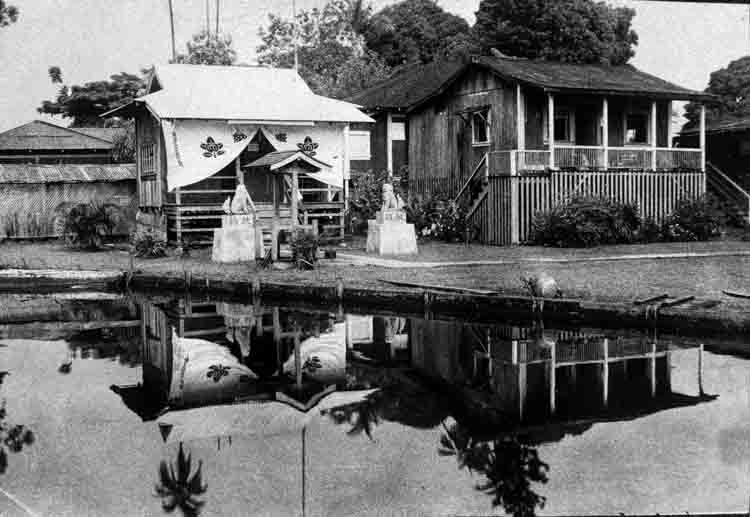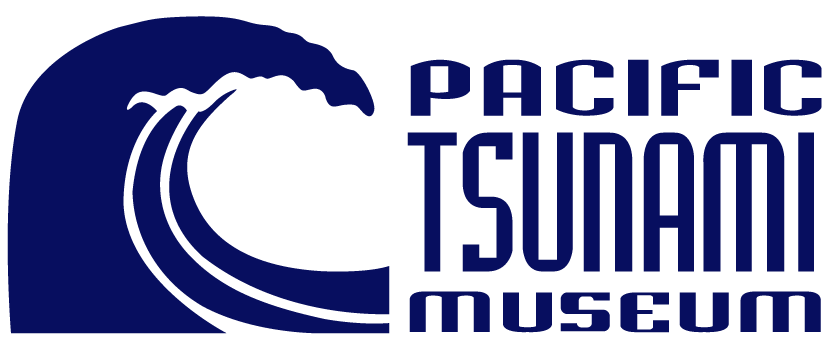Survivor Narratives: 1946
The Story of Hiromi Skeeter tsutsumi
The Suitengo Shrine
Hiromi Tsutsumi, better known as Skeeter, the oldest of nine children, grew up on the banks of the Wailoa River in what was known as Shinmachi. His father, Jungo, was twenty years old when he left Japan on August 15, 1915 on board a ship bound for Peru. The ship made a stop-over in Hilo Bay and Jungo liked what he saw, so that night he quietly got off the ship and swam ashore near the Wainaku Sugar Mill. There he was found by a Hawaiian family who took him in for a few weeks. Jungo immediately changed his name to Amano to avoid arrest since he was an illegal alien. It was a cause of confusion for young Skeeter as he grew up to have people call his father Amano-San while all the rest of the family was called Tsutsumi.

Jungo’s first job was as a common laborer at the Wainaku Sugar Company. Eventually he moved to Waiakea Town and worked for the Taniguchi Store as a Chumon tori, an order taker. He would ride his bicycle and go to the homes of Taniguchi Store customers with goods they had ordered on his previous trip, and he made lists of goods they needed to be delivered on his next delivery date.
In July of 1920 Jungo married Kameyo Okada, a Nisei who had moved to Waiakea from Honolulu. They lived in Waiakea for a few years before moving to Shinmachi near the Hilo Iron Works. Their stay there was short since Jungo managed to lease property that bordered the Wailoa River. This property had two houses with a shared outhouse and bath house that was built on a pier that extended out into the river. This pier was completely destroyed one dark night when the Waiakea Sugar Mill barge sideswiped it. The re-built outhouse and bath house were positioned along the bank of the river.
Because of the high water level on properties alongside the river, cesspools were not possible, so all the waste dispersed directly into the river. In the early 1930s the sewer system came through Shinmachi and all the outhouses and bath houses were demolished. The Tsutsumi family finally got a flush toilet but the furoya was still shared. As Skeeter remembers, “We didn’t have big houses but we had nice cottages and a nice playground in between all of that. We walked everywhere so we got to know each other well.” This is one of the very special memories Skeeter has of Shinmachi… the closeness of the people, with all the neighbors and children and their parents knowing each other”.
The Suitengo shrine beside the Tsutsumi home was built in 1935 by Jungo to honor the Water God in appreciation to the ocean for liberating him from a life of bondage.
Every New Year’s morning, Skeeter took his father up and down the Wailoa River in their rowboat and Jungo would bless every fishing vessel on the river. Nicknames were a part of life during Skeeter’s early years. Nearly all second generation children had Japanese names only; calling each other Motoyoshi, Masakatsu, and Masayuki seemed ridiculous. A few of the colorful nicknames of that time were Porky, Short Legs, Sardine, and Humpty. In later years, many of these Nisei added an English first name and their Japanese name became their middle name. Skeeter got his nickname because he parted his hair on the right since his giri-giri was on the right.
On the morning of April 1, 1946, Skeeter awoke when he heard his sisters yelling, “Tidal wave, tidal wave” as they came running home. He smiled and yelled to them “April Fool”. In no time he saw the water rising in their yard and debris and houses came floating up the river. He saw his neighbor Mr. Kuniyuki standing on the porch of his home as it floated by. The Tsutsumi family assembled and decided to go to the two-story Coca Cola building on the advice of a neighbor. The family, with children ages three to Skeeter as the oldest, joined hands and waded through swirling waters and made it to the Coca Cola Building. A while later Skeeter’s father asked him to go back to the house and gather any important items that he could carry back. Skeeter didn’t remember what all those items were but the photo albums, prints and portraits were the most important items he saved that day. When the waves finally stopped, the family returned and found their home and the Suitengo shrine gone… all they had left was debris.
